Views: 2
Superficial Peels Exfoliate the Skin and Can Help Clear Acne. Moderate & Deep Peels Can Help Reduce Scarring.

The Essential Info
Chemical peels can treat acne and/or acne scarring depending on the strength of the peel. Treating acne requires lower percentage acid, and treating scarring requires higher percentage acid.
Getting chemical peels usually involves several visits to a skincare professional such as an esthetician/cosmetician (can administer up to 30% acid), or nurse/doctor (can administer up to 70% acid). The professional carefully applies acid (e.g. glycolic acid, salicylic acid, etc.) to the skin, normally for just a few minutes (3-5 minutes is typical).
Studies show that the various acids are similarly effective, and all work to a moderate degree. However, when using chemical peels to treat acne, it is important to be aware that they should not be used on their own because they will not provide complete clearing of acne. Therefore, chemical peels for acne are normally just one part of an anti-acne plan.
Superficial Peels
Treats: Acne
Acid Concentration: Low to Moderate
- Require a professional such as an esthetician/cosmetician, nurse, or doctor.
- Side effects include skin redness, peeling for a few days after the procedure, and temporary darkening of the skin, particularly in darker-skinned individuals.
Moderate & Deep Peels
Treats: Acne Scarring
Acid Concentration: Moderate to High
- Require a professional such as an esthetician/cosmetician, nurse, or doctor.
- Moderate peels can help with minor scarring. Side effects include skin redness, peeling for a few days after the procedure, and temporary darkening of the skin, particularly in darker-skinned individuals.
- Deep peels can help with more profound scarring. Deep peels use high-concentration acids and are a serious procedure that completely remove the top layer of skin, and can cause bleeding, swelling, crusting, and prolonged skin reddening and discoloration for months after the procedure, and sometimes long term.
Over-the-counter Acids
Treats: Acne
Acid Concentration: Low
- Do not require a professional.
- Contain the same acids as many professional peels, but at lower concentrations. The most common is glycolic acid, which is widely available in up to 10% strength.
- Gently exfoliate the skin on an ongoing basis.
- Help other medications penetrate into the skin better.

The Science
- Who Can Use Chemical Peels? Caution for Darker-Skinned People
- What Are Chemical Peels?
- Types of Chemical Peels
- Superficial Peels – Treats Acne
- Moderate Peels – Treats Mainly Light Scarring
- Deep Peels – Treats Scarring
- Over-the-counter Acids
Who Can Use Chemical Peels? Caution for Darker-Skinned People
Chemical peels tend to be safest on people with a lighter skin tone because the high percentage of acids in professionally administered peels sometimes produces temporary hyperpigmentation (darkening) or even permanent hypopigmentation (lightening) of the skin in darker-skinned people. In rare cases, deeper peels can cause keloid (raised) permanent scarring in people with darker skin as well. These problems tend to increase with the percentage of acid used, so while certain superficial peels may be safe for darker-skinned individuals, it is imperative that people with darker skin speak to an experienced dermatologist before using chemical peels, with particular caution given to moderate or deep peels.
While people with darker skin need to proceed carefully when it comes to chemical peels, they can successfully and safely use over-the-counter products that contain the same acids at a lower percentage, like a 10% glycolic acid cream, gel, or serum.
What Are Chemical Peels?
Chemical peels are acids, which are applied to the skin about once every two or three weeks in either an esthetician or doctor’s office.1-2 Doctors can administer peels in up to 70% strength, and estheticians in spas and salons can administer peels in up to 30% strength. The most commonly used chemical peels are:
- Glycolic acid
- Salicylic acid
- Lactic acid
- Polyhydroxy acid
- Amino fruit acid
- Pyruvic acid
- Trichloroacetic acid (TCA)
- Jessner’s peel
The acid is left on the skin for a few minutes (3-5 is typical) and then removed. Depending on the strength and type of peel, the acids in a chemical peel cause the skin to peel and sometimes blister over a period of a few days. This exfoliation signals the cells inside the skin to regenerate faster, which can help hasten skin turnover, improve skin texture, and prevent pores from becoming clogged.1,3
From the data we currently have, all acids appear to have similar efficacy.1,3-7 For example, a recent systematic review evaluated evidence from 12 rigorous studies that tested chemical peels on people with acne. The review authors concluded that all commonly used chemical peels seem to be similarly effective for mild-to-moderate acne and have few side effects. However, the authors stressed the low quality of the studies and emphasized the need for more research on this topic.8
Expand to read details of review

This review was published in the journal BMJ Open in 2018. The researchers combed through 12 randomized controlled trials, which included a total of 387 participants. The review authors wrote, “Commonly used chemical peels appear to be similarly effective for mild-to-moderate acne vulgaris and well tolerated. However, based on current limited evidence, a robust conclusion cannot be drawn regarding any definitive superiority or equality among the currently used chemical peels.”8
Types of Chemical Peels
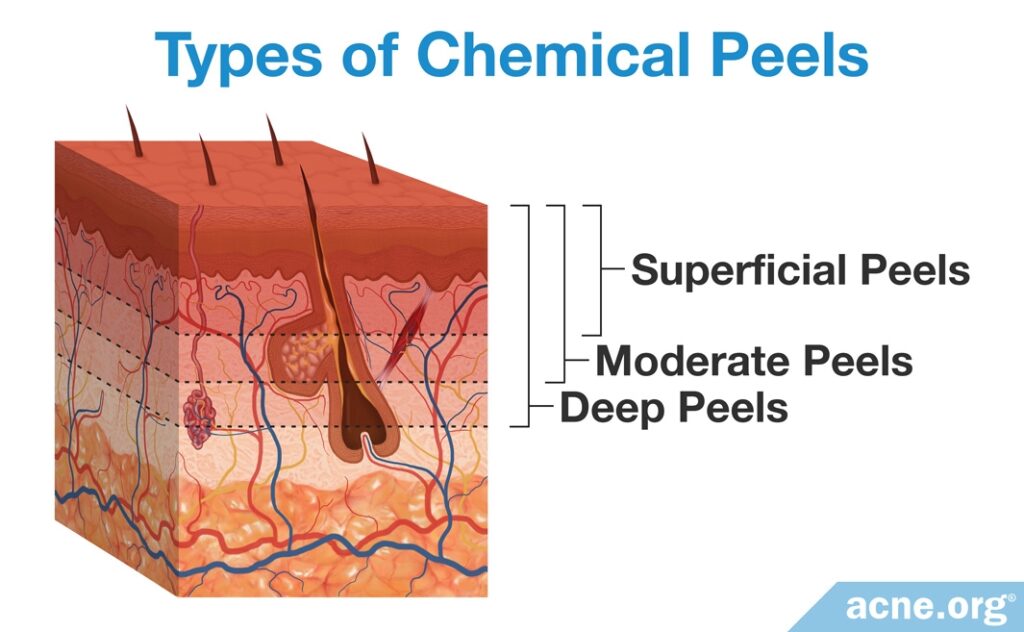
Chemical peels are classified based on the type of acid and concentration.
The main types of professionally administered chemical peels include:
- Superficial peels: Treat acne
- Moderate peels: Treat mainly minor acne scars
- Deep peels: Treat deeper acne scars
Chemical peels, especially superficial peels, can be used alongside other medications. This is often the desired course of action since chemical peels produce incomplete clearing of the skin on their own. If you decide to try a chemical peel, be sure to ask your practitioner before adding in other medications.
Superficial Peels – Treat Acne
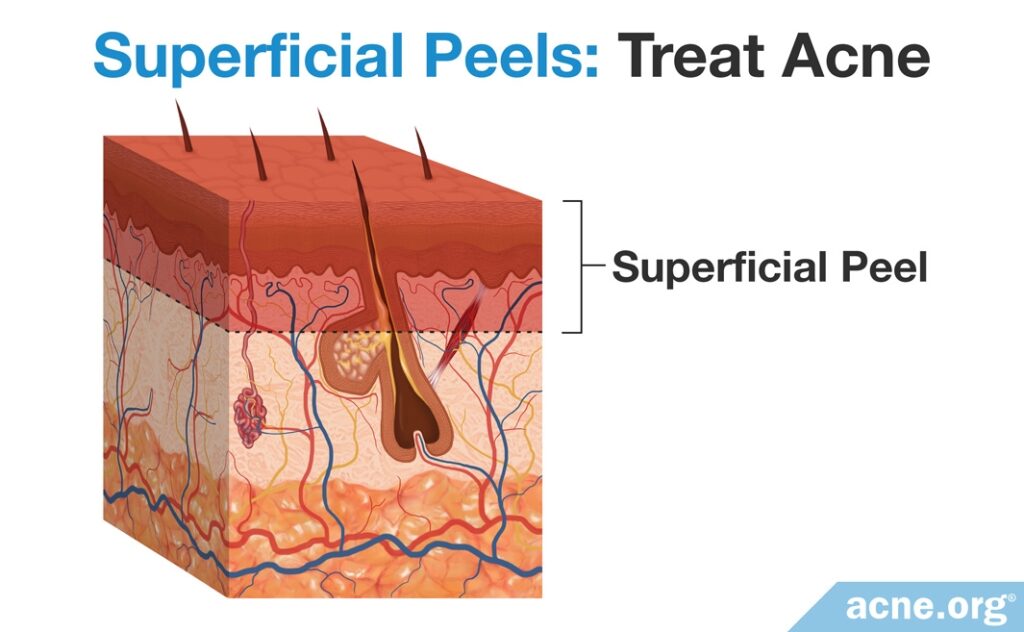
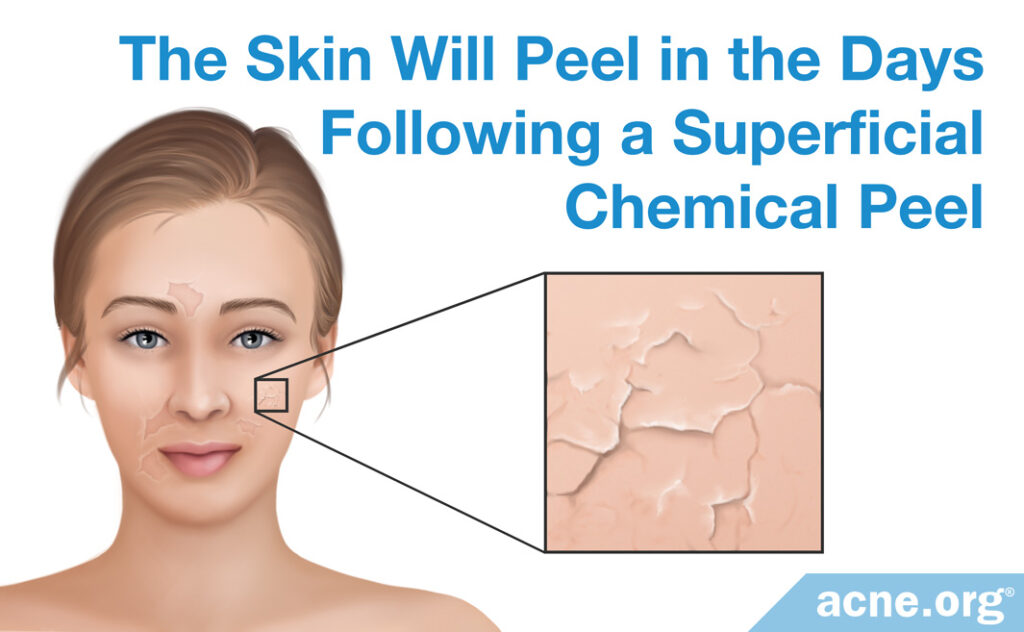
Superficial peels penetrate only the surface layer of skin, helping to shed cells on the skin’s surface. They also have anti-inflammatory properties and can help temporarily reduce skin oil secretions.
Superficial peels are lower strength than moderate or deep peels and normally use acids that belong to the alpha hydroxy acid (AHA) or beta hydroxy acid (BHA) families. The most common types of acids used are glycolic acid (AHA) and salicylic acid (BHA).1
Both glycolic and salicylic acid peels are typically administered at a concentration of 30% and can be applied either at the doctor’s office or at an esthetician’s salon.
Effectiveness: Most people report a “fair” to “good” result. Results tend to last for 1-2 months, with acne beginning to reassert itself at this time.
One recent study concluded that superficial peels produce results gradually over a series of treatments in cases of mild-to-moderate facial acne, but have little effect on severe acne.1
Expand to read details of study

According to a 2011 article in the Journal of the European Academy of Dermatology and Venereology, “when used in mild-to-moderate facial acne, superficial peels reduce acne lesions with an effect that becomes more apparent with increasing numbers of treatments. Improvements in both inflammatory and non-inflammatory lesions have been reported, but the effect on nodulocystic acne is minimal.”1
Studies have reported that salicylic acid peels reduce acne by 47 to 75%,1,6,9-11 in part through reducing the production of skin oil and slowing the growth of acne bacteria (C. acnes).12 Glycolic acid peels also appear to be effective, with 50 to 95% of patients experiencing a significant improvement in acne after at least 3 glycolic acid treatments.1,13-16 Since studies on glycolic acid did not report what the percentage improvement was, it is difficult to conclude exactly how effective glycolic peels are when compared with salicylic acid, but from what we can garner from moderate and deep peels, the type of acid is secondary to the concentration.
Side effects: Superficial chemical peels are generally well tolerated. Most people experience a sunburnt look with obvious skin peeling in the days after their first peel. This redness and peeling tends to be less pronounced with each consecutive peel. The most common side effects are dry skin, reddening, and burning sensations.1 The most severe side effects tend to be experienced after the first treatment, and subside with subsequent treatments.6 Because chemical peels remove the protective layers of the skin, your skin will be much more sensitive to sunlight.2 It is extremely important to keep your skin out of the sun after a peel and to use an adequate sunscreen until the peeling process is complete.
Moderate Peels – Treat Mainly Light Scarring
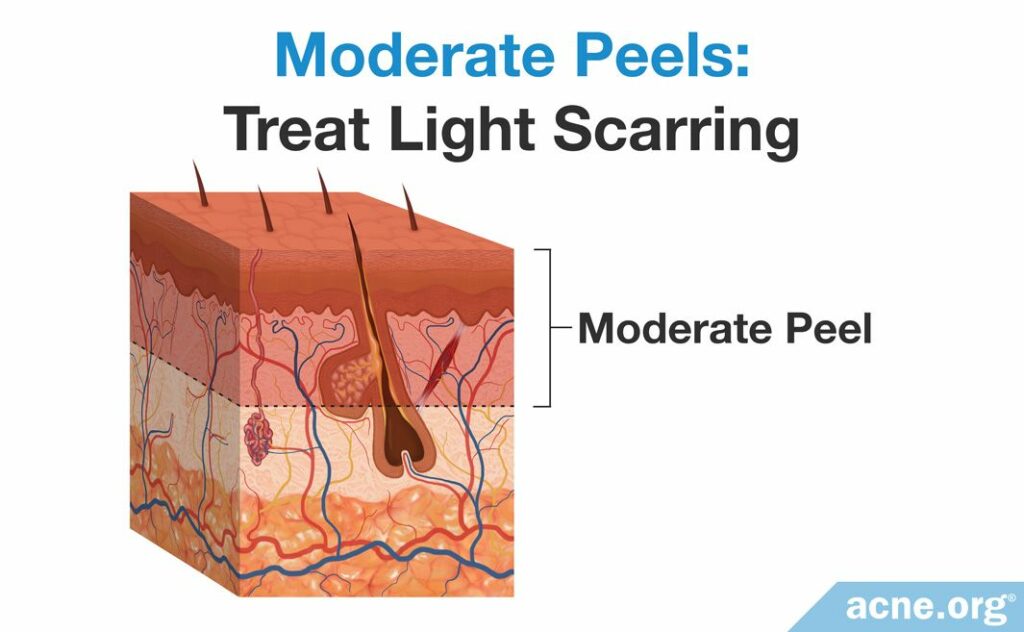

Moderately penetrating chemical peels normally use trichloroacetic acid (TCA) in 35-50% strength, which penetrates more deeply into the skin than superficial peels. TCA causes peeling of deeper layers of the skin and increases production of collagen, elastin, and other proteins which give skin its elasticity.17 However, since 50% strength TCA can cause complications, including scarring at times, doctors now often prep the skin using other methods, and then apply only 20-35% TCA. This produces similar results with fewer complications. The methods of prepping the skin before 20-35% TCA include: (1) freezing the skin with CO2 and acetone, (2) applying Jessner’s solution, a type of peel that consists of a combination of lactic acid (which helps exfoliate skin), salicylic acid (which helps skin penetration), and resorcinol (which helps break down hardened skin and treats acne), and (3) applying 70% glycolic acid.18
Effectiveness for acne scars: Two studies have looked at the efficacy of moderate peels for treating acne scars. The first study evaluated the efficacy of Jessner’s solution with 20% TCA. All 50 patients included in the study showed some improvement in their acne scars, with 60% of patients reporting “marked improvement,” which was defined as a reduction of acne scars of over 70%. The researchers wrote, “In Group I (Jessner’s peel and 20% TCA), mild improvement of acne scars was seen in 8% cases, moderate improvement in 32% cases and marked improvement of acne scars was seen in 60% patients. In Group II (20% TCA alone), mild improvement of acne scars was seen in 32% cases, moderate improvement in 40% cases and marked improvement of acne scars was seen in 28% patients.”19 The second, smaller study evaluated the effectiveness of 25% TCA for the treatment of acne scars in 13 patients. The researchers assigned a severity score to the patients’ acne scars before and after TCA peeling, and found that the treatment reduced the score by a modest 13.8%, on average. The researchers reported that 10 out of the 13 patients were satisfied with the results.20
Effectiveness for acne: Moderate peels are not normally used to treat acne. Therefore, we do not have any studies reporting on the effectiveness of moderate depth peels on acne. However, we do have 2 studies using superficial TCA on acne.
The first such clinical study investigated the effect of TCA on acne in superficial peel percentages, and it happened to be performed on darker-skinned people. The authors of that study reported that TCA treatment resulted in some improvement in acne in 85% of patients. Superficial-percentage TCA was particularly effective in treating papules and pustules (inflamed “zits” that are red and sore), and less effective in treating whiteheads and blackheads (non-inflamed white or black dots that are not red or sore). Compared to salicylic acid peels, TCA was more effective in treating whiteheads and blackheads, but less effective in treating papules and pustules. The authors stated, “This study, comparing the effect of 25% TCA and 30% salicylic acid peel in the treatment of acne vulgaris, demonstrates that both peels are successful for the treatment of moderate and mild acne in [darker] skin type patients without complications. The authors show that the 25% TCA peel is superior in treating [whiteheads and blackheads], whereas the 30% salicylic acid peel is superior in treating inflammatory lesions.”21
More recently, another study also compared the efficacy of TCA used in superficial peel percentages to 30% salicylic acid for treating acne. The study included 50 patients with mild-to-moderate acne in India. As in the previous study, the researchers found that the 25% TCA peel was better at treating whiteheads and blackheads, while the salicylic acid was better for inflammatory lesions, but the difference was small and may have been due to random chance. Overall, TCA used at a superficial peel concentration reduced acne by 54.64%, on average.22
Side effects: Because moderate peels penetrate deeper layers of the skin, they produce more severe side effects than superficial peels. These side effects include reddening of the skin, swelling, and darkening of the skin.21 In most cases, these side effects subside within one week of treatment. TCA peels are not indicated for use in patients with darker skin, as they may result in permanent darkening of the skin in the area where the peel was used. However, this problem can be overcome if TCA is used in combination with Jessner’s solution. According to researchers, “…Jessner’s solution can be an adjuvant treatment with TCA in the treatment of acne scars, improving the results and minimising post inflammatory hyperpigmentation. Using modified Jessner’s solution combined with 20% TCA, the risk of post inflammatory hyperpigmentation, which occurs in dark skinned persons after TCA peels, can be reduced.”21 As with any type of peel, it is important that you carefully avoid any sun exposure whatsoever in the days following the peel.
Deep Peels – Treat Scarring
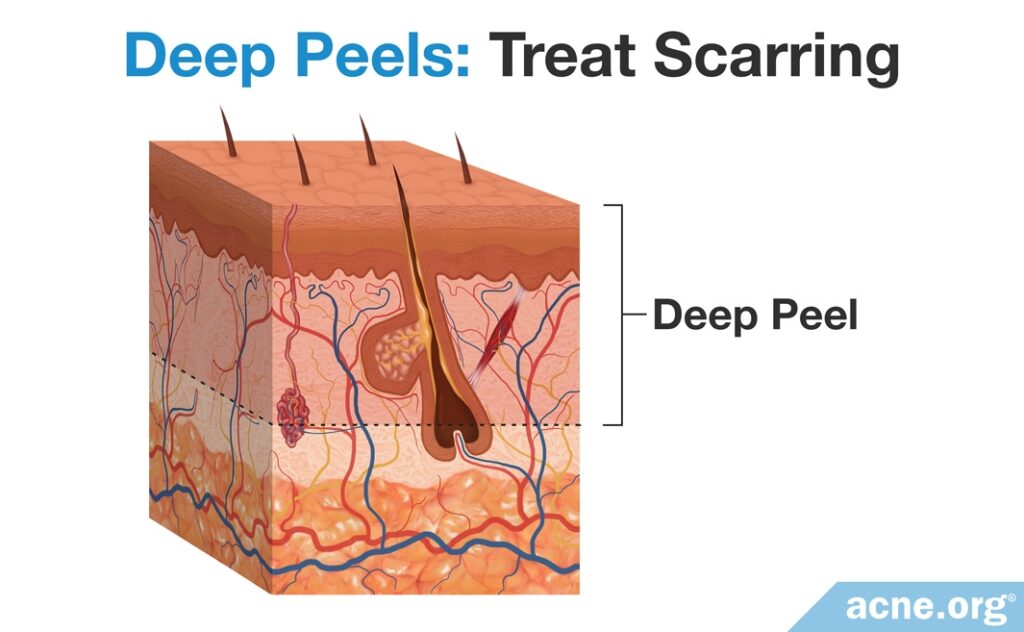
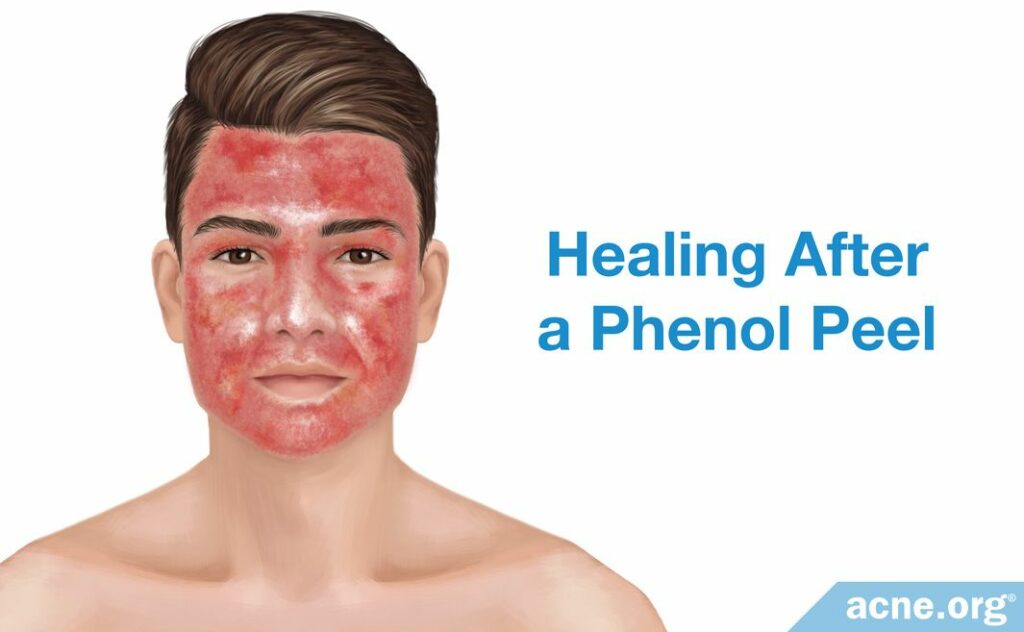
Deep peels penetrate most deeply into the skin and are used to treat deeper acne scars. Deep peels use phenol at a concentration of 88%. In some cases, phenol is combined with croton oil. Deep peels work by breaking down proteins in the skin and stimulating production of collagen in the regenerated skin.23
Warning: Because deep peels use very strong acids, the procedure is akin to plastic surgery and must be administered by a skilled and highly trained dermatologist. Improper application can cause permanent disfigurement.
Effectiveness: A clinical study on 10 patients with acne scars reported that a phenol peel reduced acne scars by 75%.24 The researchers wrote, “Acne scarring improved in 100% of patients. The overall scar severity score improved by a mean of 75.12%.”24
Another study, conducted in 11 patients showed that phenol peels reduced acne scars. The researchers wrote, “The acne scars group had an improvement of over 51% in 64% of the cases.”25
Side effects: Deep chemical peels completely remove the top layer of the skin. Side effects of deep chemical peels are severe and include bleeding, swelling, crusting, and prolonged reddening of the skin and skin discoloration.23 These side effects can be long lasting and can take up to 6 months to go away.25 Unlike superficial and moderate peels, phenol peels are absorbed through the skin into the bloodstream and can cause breathing problems, kidney problems, and serious heart complications.23,25 Deep peels are not indicated for darker-skinned individuals because of the chance of permanent skin lightening and the potential for keloid scarring. Similar to the lighter types of peels, it is absolutely vital to avoid any sun exposure whatsoever after a deep chemical peel for the amount of time determined by the doctor.
Over-the-counter Acids – Treat Acne
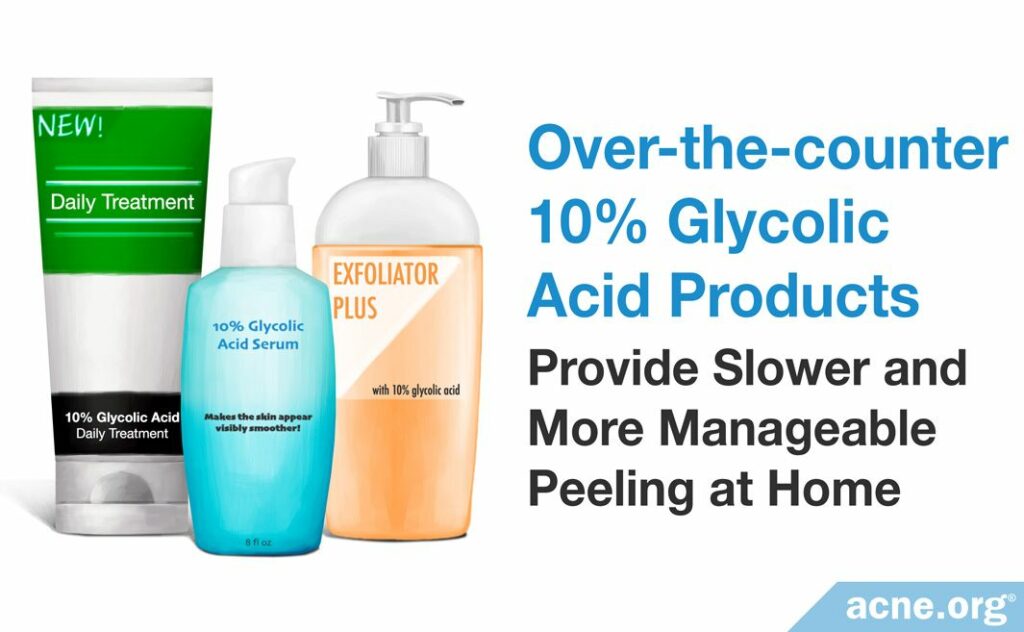
There are lower-strength acids available over-the-counter that can be applied at home on a more regular basis, producing a slower and more manageable exfoliation of the top layers of the skin without the side effects and cost of professionally administered chemical peels. An example of this is 10% glycolic acid. Most people can handle this type of over-the-counter product every other night.
For most people who are looking to treat acne, this is normally the way to go. However, over-the-counter acids do nothing for scarring.
References
- Dreno, B. et al. Expert opinion: efficacy of superficial chemical peels in active acne management–what can we learn from the literature today? Evidence-based recommendations. J. Eur. Acad. Dermatol. Venereol. 25, 695 – 704 (2011). https://www.ncbi.nlm.nih.gov/pubmed/21029205
- Kornhauser, A., Coelho, S. G. & Hearing, V. J. Applications of hydroxy acids: classification, mechanisms, and photoactivity. Clin. Cosmet. Investig. Dermatol. 3, 135 – 142 (2010). https://www.ncbi.nlm.nih.gov/pmc/articles/PMC3047947/
- Kempiak, S. J. & Uebelhoer, N. Superficial chemical peels and microdermabrasion for acne vulgaris. Semin. Cutan. Med. Surg. 27, 212 – 220 (2008). https://www.ncbi.nlm.nih.gov/pubmed/18786500
- Bae, B. G. et al. Salicylic acid peels versus Jessner’s solution for acne vulgaris: a comparative study. Dermatol. Surg. 39, 248 – 253 (2013). https://www.ncbi.nlm.nih.gov/pubmed/23121256
- Ilknur, T., Demirtasoglu, M., Bicak, M. U. & Ozkan, S. Glycolic acid peels versus amino fruit acid peels for acne. J. Cosmet. Laser. Ther. 12, 242 – 245 (2010). https://www.ncbi.nlm.nih.gov/pubmed/20825257
- Kessler, E., Flanagan, K., Chia, C., Rogers, C. & Glaser, D. A. Comparison of alpha- and beta-hydroxy acid chemical peels in the treatment of mild to moderately severe facial acne vulgaris. Dermatol. Surg. 34, 45 – 50; discussion 51 (2008). https://www.ncbi.nlm.nih.gov/pubmed/18053051
- Raone, B. et al. Salicylic acid peel incorporating triethyl citrate and ethyl linoleate in the treatment of moderate acne: a new therapeutic approach. Dermatol. Surg. 39, 1243 – 1251 (2013). https://www.ncbi.nlm.nih.gov/pubmed/23627892
- Chen, X., Wang, S., Yang, M. & Li, L. Chemical peels for acne vulgaris: a systematic review of randomised controlled trials. BMJ Open. 8, e019607 (2018). https://www.ncbi.nlm.nih.gov/pubmed/29705755
- Hashimoto, Y. et al. Salicylic acid peels in polyethylene glycol vehicle for the treatment of comedogenic acne in Japanese patients. Dermatol. Surg. 34, 276 – 279 (2008). https://www.ncbi.nlm.nih.gov/pubmed/18177407
- Grimes, P. E. The safety and efficacy of salicylic acid chemical peels in darker racial-ethnic groups. Dermatol. Surg. 25, 18 – 22 (1999). https://www.ncbi.nlm.nih.gov/pubmed/9935087
- Lee, H. S. & Kim, I. H. Salicylic acid peels for the treatment of acne vulgaris in Asian patients. Dermatol. Surg. 29, 1196 – 1199; discussion 1199 (2003). https://www.ncbi.nlm.nih.gov/pubmed/14725662
- Shao, X., Chen, Y., Zhang, L., Zhang, Y., Ariyawati, A., Chen, T., Chen, J., Liu, L., Pu, Y., Li, Y. & Chen, J. Effect of 30% supramolecular salicylic acid peel on skin microbiota and inflammation in patients with moderate-to-severe acne vulgaris. Dermatol. Ther. (Heidelb). 13, 155-168 (2023). https://pubmed.ncbi.nlm.nih.gov/36350527/
- Sharad, J. Glycolic acid peel therapy – a current review. Clin. Cosmet. Investig. Dermatol. 6, 281 – 288 (2013). https://www.ncbi.nlm.nih.gov/pubmed/24399880
- Wang, C. M., Huang, C. L., Hu, C. T. & Chan, H. L. The effect of glycolic acid on the treatment of acne in Asian skin. Dermatol. Surg. 23, 23 – 29 (1997). https://www.ncbi.nlm.nih.gov/pubmed/9107290
- Grover, C. & Reddu, B. S. The therapeutic value of glycolic acid peels in dermatology. Indian J. Dermatol. Venereol. Leprol. 69, 148 – 150 (2003). https://www.ncbi.nlm.nih.gov/pubmed/17642863
- Atzori, L., Brundu, M. A., Orru, A. & Biggio, P. Glycolic acid peeling in the treatment of acne. J. Eur. Acad. Dermatol. Venereol. 12, 119 – 122 (1999). https://www.ncbi.nlm.nih.gov/pubmed/10343939
- Handog, E. B., Datuin, M. S. & Singzon, I. A. Chemical peels for acne and acne scars in asians: evidence based review. J Cutan Aesthet Surg 5, 239 – 246 (2012). https://www.ncbi.nlm.nih.gov/pubmed/23378705
- Herbig, K., Trussler, A. P., Khosla, R. K. & Rohrich, R. J. Combination Jessner’s solution and trichloroacetic acid chemical peel: technique and outcomes. Plast. Reconstr. Surg. 124, 955 – 964 (2009). https://www.ncbi.nlm.nih.gov/pubmed/19730318
- Puri, N. Efficacy of Modified Jessner’s Peel and 20% TCA Versus 20% TCA Peel Alone for the Treatment of Acne Scars. J. Cutan. Aesthet. Surg. 8, 42 – 45 (2015). https://www.ncbi.nlm.nih.gov/pmc/articles/PMC4411592/
- Al-Hamamy, H. R., Al-Dhalimi, M. A. & Abtan, A. F. Evaluation of treatment of acne scars with 25% trichloroacetic acid chemical peel followed by manual dermasanding. J. Cosmet. Dermatol. 20, 1750-1755 (2021). https://pubmed.ncbi.nlm.nih.gov/32998175/
- Abdel Meguid, A. M., Elaziz Ahmed Attallah, D. A. & Omar, H. Trichloroacetic Acid Versus Salicylic Acid in the Treatment of Acne Vulgaris in Dark-Skinned Patients. Dermatol. Surg. 41, 1398 – 1404 (2015). https://www.ncbi.nlm.nih.gov/pubmed/26551771
- Dayal, S., Singh, S. & Sahu, P. Efficacy and safety of 25% trichloroacetic acid peel versus 30% salicylic acid peel in mild-to-moderate acne vulgaris: A comparative study. Dermatol. Pract. Concept. 11, e2021063 (2021). https://pubmed.ncbi.nlm.nih.gov/34123563/
- Rendon, M. I. et al. Evidence and considerations in the application of chemical peels in skin disorders and aesthetic resurfacing. J. Clin. Aesthet. Dermatol. 3, 32 – 43 (2010). https://www.ncbi.nlm.nih.gov/pubmed/20725555
- Leheta, T. M., Abdel Hay, R. M. & El Garem, Y. F. Deep peeling using phenol versus percutaneous collagen induction combined with trichloroacetic acid 20% in atrophic post-acne scars; a randomized controlled trial. J. Dermatolog. Treat. 25, 130 – 136 (2014). https://www.ncbi.nlm.nih.gov/pubmed/22397516
- Park, J. H., Choi, Y. D., Kim, S. W., Kim, Y. C. & Park, S. W. Effectiveness of modified phenol peel (Exoderm) on facial wrinkles, acne scars and other skin problems of Asian patients. J. Dermatol. 34, 17 – 24 (2007). https://www.ncbi.nlm.nih.gov/pubmed/17204096
The post Chemical Peels for Acne appeared first on Acne.org.

